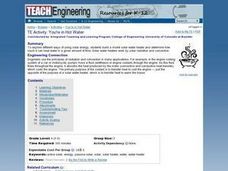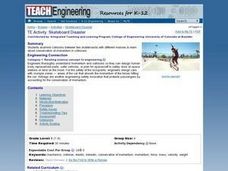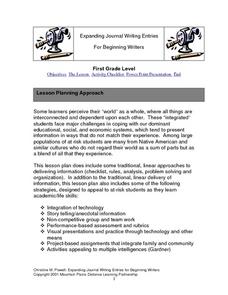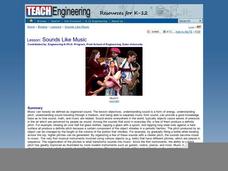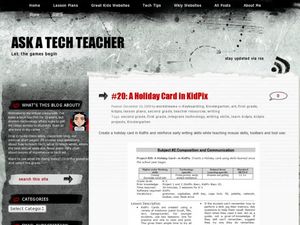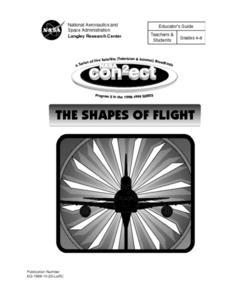Curated OER
Tornado!
Young scholars examine the characteristics and types of tornadoes. They discuss how they are formed, conduct an experiment with two liter bottles, analyze data and determine mean and median, and design a house to withstand tornado-force...
Curated OER
Engineering Pop-Ups
Learners explore the art of paper engineering and pop-up-books. They listen to a teacher-led lecture on pop-up books, discuss the process of paper engineering, and plan, design and construct an original pop-up book.
Curated OER
TE Activity: Heavy Helicopters
Students study the concepts of weight and drag while making paper helicopters. They measure how adding more weight to the helicopter changes the time for the helicopter to fall to the ground. They apply what they examine to the work of...
Curated OER
TE Activity: Muscles, Muscles Everywhere
Young scholars study three different muscle types and investigate the affect of space travel on astronauts' muscles. They examine how exercise has a positive affect on muscle both on Earth and in space while looking at engineers' roles...
Curated OER
TE Activity: You're in Hot Water
Students study different ways of using solar energy. They design a solar water heater and determine how much water it can heat in a set amount of time. They examine how the heaters work by solar radiation and convection.
Curated OER
Skateboard Disaster
Learners conduct a hands-on experiment with collisions between two skateboards of different masses. They are introduced to the concept of conservation of momentum in collisions and consider how their observations might help engineers...
Curated OER
TE Lesson: Energy Transfer in Musical Instruments
Students study concepts of energy and energy transfer. They look at how these concepts apply to musical instruments. They study the law of conservation of energy. They use the concepts studied in the lesson plan to design a musical...
Curated OER
How Do Things Fall?
Students study forces by examining the force of gravitational attraction. They observe how objects fall and measure the force of gravitational attraction upon objects. Students discover that, since gravitational constants are different...
Curated OER
Simple Machines and Modern Day Engineering Analogies
Learners apply the mechanical advantages and problem-solving capabilities of six types of simple machines (wedge, wheel and axle, lever, inclined plane, screw, pulley) as they discuss modern structures in the spirit of the engineers and...
Curated OER
Do You Have the Strength?
Students examine the strength and resilience of the human heart. They squeeze a tennis ball to demonstrate the strength of the human heart, record and analyze the results on a worksheet, and create a poster of a design of a device to...
Curated OER
Expanding Journal Writing Entries For Beginning Writers
First graders through a variety of strategies assess how to write in journals openly and effectively. Those strategies include integration of technology, story telling, group and team work, performance-based assessment/rubrics, visual...
Curated OER
All Aboard the Innovation Train
Learners read "Next Stop for the Subway, a Fully Automated Future" from The New York Times and consider the effect of technology on their town or city. After discussing arguments for and against the new computer-based subway system in...
Curated OER
Keep Your Bubbles Up
Students investigate design and the correct use of technology. In this chemistry instructional activity, students investigate the Bernoulli Principle using hands on bubble making. They link the principle that keeps the bubble aloft to...
Curated OER
TE Lesson: Pollution Solutions
Learners study how industrial technology helps clean up and prevent air pollution. They role play as engineers to examine methods of engineering pollutant recovery methods such as scrubbers, electrostatic precipitators, cyclones, and...
Curated OER
Sounds Like Music
Students define and examine the connections between sound and music and how engineers design instruments. They listen to examples of musical instruments, view a demonstration of a tuning fork and bottles filled with varying amounts of...
Curated OER
TE Activity: Hot or Not
Students examine how the human immune system responds to germs and explain what a fever is. They design a thermometer in order to further explore temperature before completing a temperature conversion worksheet. They detail the work of...
Curated OER
TE Lesson: Using Heat from the Sun
Students examine fossil fuels, nuclear and renewable fuels. They study investigate types of heat transfer such as convection, conduction, and radiation. They complete crossword puzzles based on the vocabulary. They design, construct and...
Curated OER
A Holiday Card in KidPix
Students create a holiday card using computer software. In this computer card making lesson, students design an original holiday card using a variety of tools. Students navigate the software utilizing various tools.
Curated OER
Naturral Born Robots: Robots Have Feelings Too
Students explore robotics. They design a simple device that simulates a human arm lifting a mass. Students test the strength of their arm. Students discuss artificial intelligence.
Curated OER
The Shapes of Flight
Students explore interaction between mathematics, science, and technology as they look at process of researching, developing, testing, and evaluating airplane design. They calculate glide ratio for model paper airplane by using data...
Curated OER
Activity Five: The Horseless Carriage
Students identify features that make an automobile practical for a cross-country trip and then design a 1903 era auto using lessons learned from Horatio's journey.
Curated OER
Collisions and Momentum: Bouncing Balls
Middle schoolers explore the concepts of potential and kinetic energy by bouncing assorted balls on different surfaces and calculating the momentum for each ball. They give examples of collisions and momentum in sports and understand...
Curated OER
The Human Memory
This is a well-designed, creative lesson to help students learn more about the human memory. Working in pairs, students complete tasks and gather data. Excellent websites for resources are also provided.
Curated OER
Earthquakes Rock!
Students study the main methods to measure earthquakes; the Richter Scale and Mercalli Scale. They make a model of a seismograph and investigate which structural designs are most likely to survive an earthquake.






